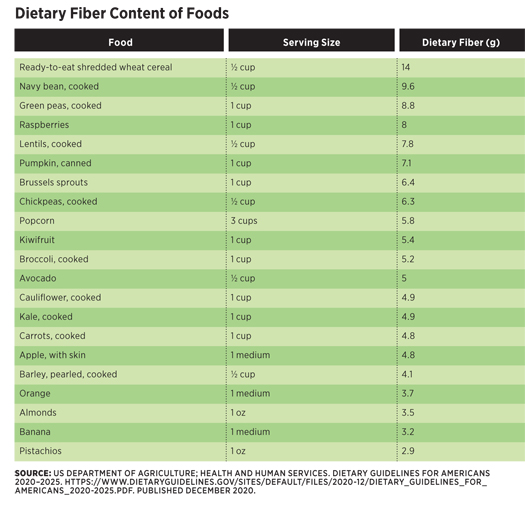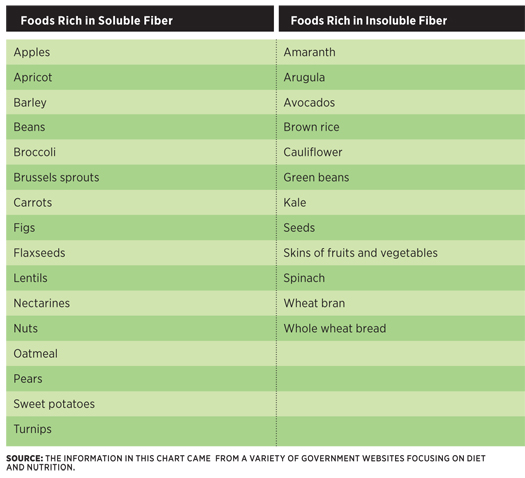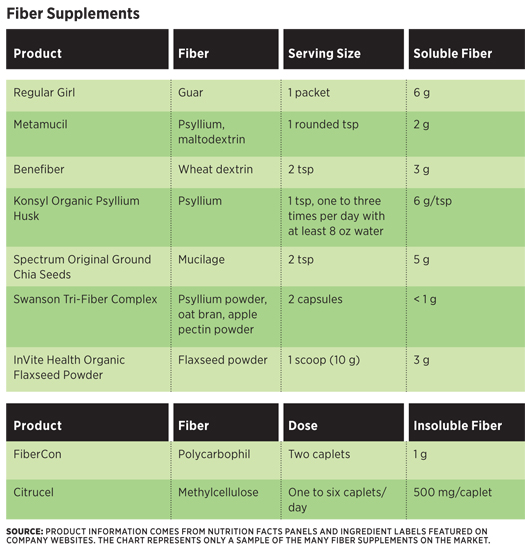Today’s Dietitian
Vol. 25 No. 2 P. 14
Fiber is a perennial topic of interest for health-conscious consumers. Several studies, as well as meta-analyses, have established an association between fiber and a reduced risk of several chronic diseases, including colon cancer, CVD, and type 2 diabetes.1-3 The Academy of Nutrition and Dietetics recommends a dietary fiber intake of 14 g for every 1,000 kcal per day, or a daily intake of about 25 g for women and 38 g for men.4 Individual fiber needs vary depending on calorie intake, gender, age, and health status. The age and gender-based fiber intakes recommended by the 2020–2025 Dietary Guidelines for Americans are listed below. However, according to the Dietary Guidelines, only about 5% of American adults get the recommended amount of fiber from their diets. That prompted the Dietary Guidelines Advisory Committee to include dietary fiber in the list of dietary components that are considered to be public health concerns.5 “This is a big topic in my private practice,” says Nancy Farrell Allen, MS, RDN, FAND, a spokesperson for the Academy of Nutrition and Dietetics and owner of Farell Dietitian Services in Fredericksburg, Virginia. Allen believes fiber is one of the most important nutrients and is a proponent of meeting fiber needs in the diet.
2020–2025 Dietary Guidelines’ Recommended Fiber Intakes
• Women aged 51 and up should consume 22.4 g fiber each day.
• Women aged 31 to 50 should consume 25.2 g fiber each day.
• Women aged 19 to 30 should consume 28 g fiber each day.
• Men aged 51 and up also should consume 28 g fiber each day.
• Men aged 31 to 50 should consume 30.8 g fiber each day.
• Men aged 19 to 30 should consume 33.6 g fiber each day.
Soluble and Insoluble Fiber
In the broadest sense, dietary fiber is the indigestible part of plant material. A systematic review and meta-analysis, published in 2020, found that participants in prospective cohort studies who consumed higher intakes of dietary fiber had a reduced risk of premature death when compared with those with lower fiber intakes.3 A fiber-rich diet was associated with a 15% to 30% reduced risk of death and chronic disease in people who consumed the most dietary fiber. More specifically, on average, a high fiber intake was associated with a 22% reduced risk of stroke and a 16% lower risk of type 2 diabetes and colorectal cancer.3


There’s evidence that soluble fibers, such as those found in oatmeal, lentils, and pears, can lower serum cholesterol and improve glycemic control in people with type 2 diabetes. Insoluble fibers, such as those found in brown rice, wheat bran, and green beans significantly increase stool water content and increases bulk, providing a laxative effect.6 Most fibers are not exclusively soluble or insoluble but typically are dominated by one or the other.7 “I always counsel my patients on the difference between insoluble and soluble fiber,” Farrell says. “My advice is to read product labels to understand ingredients, instructions, and interactions for the best outcome.”
Fiber Supplements
For the overwhelming majority of Americans, who don’t get enough fiber in their diets, fiber supplements are an option. Fiber supplements are isolated and concentrated fiber sources in the form of powders, tablets, capsules, or gummies, but they don’t provide all of the vitamins, minerals, and phytochemicals present in foods, and therefore can’t offer many of the health benefits associated with consumption of fiber-rich foods.

It’s important for RDs to be familiar with these supplements and educate clients and patients on the different types of fiber supplements, how they work, and how they differ from food sources of fiber. There are several fiber supplement products on the market from which to choose. Some contain natural fibers, such as inulin (chicory root), psyllium (the husk of the psyllium seed), or beta-glucan (from oats or barley). Others contain an artificially created ingredient, such as polydextrose (a synthetic polymer of glucose and sorbitol), wheat dextrin (heat/acid-treated wheat starch), or methyl-cellulose (semisynthetic, chemically treated wood pulp).6 Farrell says physicians usually recommend the most well-known brands of fiber supplements, such as those listed in the “Fiber Supplements” chart. However, she says supplements have relatively low levels of fiber. “Some foods have just as much or more fiber in one serving. Why not enjoy food for the taste, aroma, experience, and additional plant nutrients provided?” Because of this, advise patients to check Nutrition Facts panels for the amount of fiber per serving. Some supplements provide 1 g or less per serving.
While general statements can be made about the effects of specific types of fiber supplements, differences in their effects exist among individuals. Soluble fiber from gel-forming fiber supplements has been associated with fewer highs and lows in postprandial glucose in people with type 2 diabetes. It may reduce the required dose of hypoglycemic drugs, but not in everyone.7 It also has been shown to lower blood cholesterol, but in one recent study, while the majority of subjects experienced a reduction in cholesterol after consuming a soluble fiber supplement, not all responded. These differences could be due to individual dissimilarities in the microbiome, the specific fiber source, people’s unique genetic makeup, or some combination of the three.8 Researchers from Stanford School of Medicine studied the effects of fibers on individuals and found that there are significant differences in how people react to fiber supplements, and the effect isn’t always beneficial. The study, which was published in Cell Host & Microbe, reported that high doses of inulin could cause inflammation in some, but not in others who take it.
According to Mount Sinai Medical Center in New York, an important consideration when counseling a client or patient about taking a fiber supplement is whether it might interfere with any prescription medications they’re taking, including tricyclic antidepressants; cholesterol-lowering medications, such as cholestyramine; seizure medications, such as carbamazepine; diabetes medication, such as metformin; and digoxin and lithium.9
Farrell says encourage clients and patients to drink plenty of water to soften the fiber as it moves through the gastrointestinal tract. But she always prioritizes food sources of fiber. “I tell my patients that half of their grocery cart should consist of produce and high-fiber foods.” Focusing on that advice with clients and patients can help them meet, or at least come close to meeting, the recommendations for fiber intake.
— Densie Webb, PhD, RD, is a freelance writer, editor, and industry consultant based in Austin, Texas.
References
1. Reynolds A, Mann J, Cummings J, Winter N, Mete E, Te Morenga L. Carbohydrate quality and human health: a series of systematic reviews and meta-analyses. Lancet. 2019;393(10170):434-445.
2. Soliman G. Dietary fiber, atherosclerosis and cardiovascular disease. Nutrients. 2019;11(5):1115.
3. Reynolds AN, Akerman AP, Mann J. Dietary fibre and whole grains in diabetes management: systematic review and meta-analyses. PLoS Med. 2020;17(3):e1003053.
4. Fiber 2020. American Academy of Nutrition and Dietetics website. https://www.eatright.org/food/vitamins-and-supplements/nutrient-rich-foods/fiber#:~:text=The%20recommended%20amount%20of%20dietary,depending%20on%20your%20energy%20needs. Accessed November 7, 2022.
5. US Department of Agriculture; US Department of Health and Human Services. Dietary Guidelines for Americans, 2020-2025. https://www.dietaryguidelines.gov/sites/default/files/2020-12/Dietary_Guidelines_for_Americans_2020-2025.pdf. Published December 2020.
6. Lambeau KV, McRorie JW. Fiber supplements and clinically proven health benefits: how to recognize and recommend an effective fiber therapy. J Am Assoc Nurse Pract. 2017;29(4):216-223.
7. McRorie JW Jr. Evidence-based approach to fiber supplements and clinically meaningful health benefits, part 1: what to look for and how to recommend an effective fiber therapy. Nutr Today. 2015;50(2):82-89.
8. Lancaster SM, Lee-McMullen B, Abbott CW, et al. Global, distinctive, and personal changes in molecular and microbial profiles by specific fibers in humans. Cell Host Microbe. 2022;30(6):848-862.9. Fiber. Mount Sinai, website. https://www.mountsinai.org/health-library/supplement/fiber. Accessed November 7, 2022.



